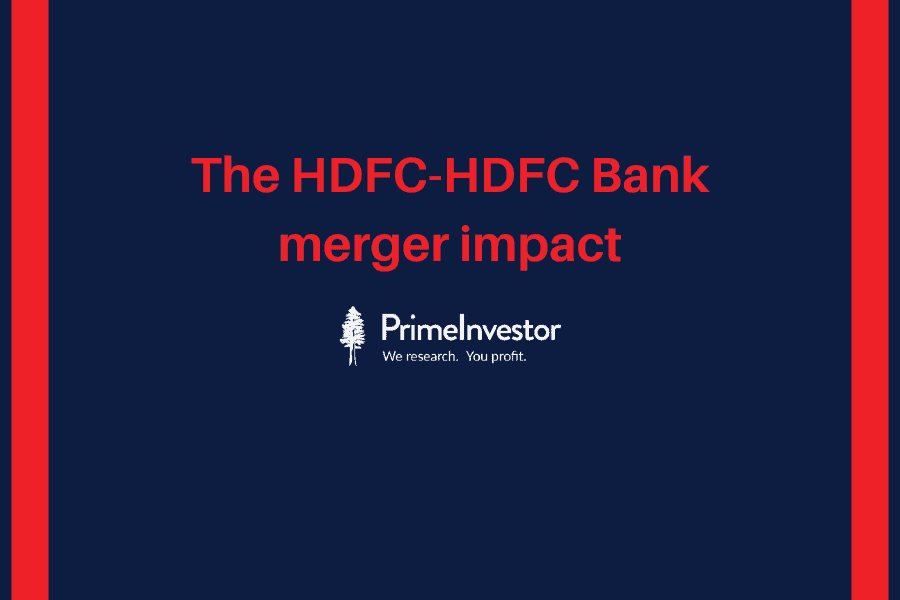Shareholders of HDFC will now become holders of HDFC Bank. What could be in store for the new combined entity and what will be the HDFC Bank merger impact? With the merger clearing formidable regulatory hurdles and set to take effect from July 13, HDFC is set to stop trading as an independent entity. Should you retain your now-HDFC Bank shares?

Housing Development Finance Corporation (HDFC) has been part of Prime Stocks for a long time now. We had first given a buy call at Rs 2747 in January 2021 as we thought it would make for good defensive bet during Covid. We reiterated the buy call at Rs 2194 in March 2022, expecting a take-off in home loan demand. At the current market price of close to Rs 2795.9, the stock hasn’t done much from the initial buy price, but has delivered a 27% return from our March 2022 buy call.
On the effective date, HDFC shareholders will receive 42 shares of HDFC Bank for every 25 shares they own in HDFC. Our call on the HDFC stock, thus, is as follows:
- We are changing the stock of HDFC from Buy to a Hold.
- We recommend that you hold on to you HDFC shares to receive HDFC Bank shares.
- Post the merger, the HDFC stock in the Hold list in Prime Stocks will change to HDFC Bank
- We believe that this merger will unlock significant growth triggers for HDFC Bank over a 3 to 4-year time frame. But the next one year is likely to prove challenging for loan growth, margins and EPS growth, acting as a dampener to stock price performance.
Merger: Medium-term positives
Here’s why we think the merger has the potential to act as a growth trigger for HDFC Bank over a 3 to 4-year perspective.
Not a distress merger
Indian investors have learnt to be suspicious of mergers in the financial sector, as they usually prompted by one of the entities piling up bad loans, facing deposit run-downs and seeking a rescuer to rebuild trust. With unexpected bad loans tumbling out of the closet post-merger, the merged entity usually takes a profit and capital hit.
But the HDFC-HDFC Bank merger is an exception. Driven by the blurring regulatory divide between NBFCs and banks, this merger will see two highly trusted financial institutions with an impressive underwriting record come together.
For HDFC Bank investors, the incoming home loan business brings in a secured retail loan book with very low delinquencies. HDFC reported gross NPAs of 1.18% for the quarter ending March 2023 and carried excess provisions (Rs 12,145 crore against gross NPAs of Rs 7246 crore). HDFC Bank in end-March 2023, also carried low gross NPAs of 1.12% with provisions at 182%. Therefore, nasty surprises on asset quality or provisioning are highly unlikely after this merger.
With HDFC Bank carrying a CRAR of 24.3% against 19.3% for HDFC Bank, the combined entity will be comfortably placed on meeting capital adequacy, with no need for equity raising in the near future. The extinguishment of HDFC’s shareholding of 20.9% in the bank’s equity (116.46 crore shares), will soften the impact of the equity dilution on the bank.
Benefits of scale
Globally, large banks survive cataclysmic financial upheavals while smaller ones get liquidated or consolidated. Regulators are also are more than willing to provide liquidity support and bailout packages to giant banks during crises.
The banking behemoth arising from the merger of HDFC with HDFC Bank is unlikely to ever need a bailout. And the combine will enjoy the advantages of scale on the following counts:
- The merged HDFC Bank is expected to trade at marketcap of $170 billion placing it among the top five banks globally, and make the stock the top weight in the Nifty 50. This should make it an automatic part of large global institutional portfolios tracking the India story.
- HDFC Bank will start off with a loan book of Rs 22.45 lakh crore and a deposit book of Rs 20.63 lakh crore (proforma numbers as of end-June 2023). It will rank the second largest in India after SBI on both loans and deposits (Rs 32 lakh crore and Rs 44 lakh crore respectively), with the third largest ICICI Bank lagging well behind. HDFC Bank post-merger is expected to sit on a massive 15% share of incremental advances in the Indian banking system and a 20% share of incremental deposits. As size engenders trust, the bank may be able to raise deposits at lower costs than rivals and price its loans higher. Raising funds from global markets may be easier.
- For consumer-facing businesses in India, physical presence in semi-urban and rural areas is a big moat, to tap into under-served customers without the fear of under-cutting by rivals. Pre-merger, HDFC Bank has been making large investments in branch expansion, making a big push into rural and semi-urban centres. The merger will give HDFC Bank access to 737 branches of the former HDFC apart from its own 7821 branches. Post-merger HDFC Bank expects to mark its presence across 90% of India’s districts, including in 1.65 lakh villages, offering an edge in products such as retail loans, gold loans and MSME loans.
- The limited overlap between HDFC and HDFC Bank customer base creates large cross-selling opportunities not only for loan products but also for fee income from selling the mutual fund and insurance products of the group. 70% of HDFC’s 40 million customers don’t have an account with the bank. Only 2% of HDFC Bank’s 83 million customers have a home loan from HDFC, with 93% having no home loan. The resulting cross-selling opportunity can power growth both for HDFC Bank’s retail loans and for the acquired mortgage business.
Preparing for growth
In an upbeat credit cycle, acquiring a liability franchise is a bigger challenge for a bank than acquiring loan customers. HDFC Bank has been on a branch expansion and deposit acquisition spree in the last three years.
Adding branches at a run rate of 600 per quarter lately, the bank has seen its branch network rise from about 5,600 to 7,800 in the two years to FY23, with 52% of them in semi-urban and rural areas. It plans to add branches at the same pace going ahead. It has been on a hiring spree too, adding over 31000 people in FY23 to take the total staff count to over 1.7 lakh. As a result, the bank added over 10 million new customers in FY23 against 3 million in FY18.
Branch and employee additions contribute to deposit and loan growth with a lag of 1.5-2 years. But the additions have been showing up in HDFC Bank’s numbers already. While deposits for all domestic banks grew by 9.6% in FY23, HDFC Bank managed 21% deposit growth. HDFC Bank’s advances growth for FY23 at 17% also beat industry growth of 15%.
But HDFC Bank was among the few banks to manage incremental deposit accretion at a faster pace than loan growth. The bank’s increasing share in commercial and MSME loans has also been powering deposit flows from these segments. The healthy deposit accretion positions the bank well for its ambitious plan of doubling its balance sheet every 4 years.
Improved loan mix
The home loan market is the most competitive in India today with both banks and NBFCs outbidding each other to acquire these secured loans with historically low delinquency rates. With the merger of HDFC into it, HDFC Bank acquires a readymade Rs 7.2 lakh crore, largely retail, mortgage-dominated portfolio.
The addition is likely to result in home loans making up 25% of HDFC Bank’s loan book post-merger compared to just 6% now. This has two positive spinoffs for the bank. One, with HDFC’s loans lifting the proportion of retail loans in its portfolio to over 50%, HDFC Bank will edge closer to rivals such as ICICI Bank and Axis Bank on high-growth, high-yield retail loans. The bank’s traditional strengths in working capital, MSME and corporate lending may stand it in good stead, should the retail lending boom go awry in future.
Two, with home loans typically carrying longer tenor, the bank can leverage on the incoming customers to cross-sell other loan and fee income products. On the flip side though, the addition of more mortgage loans will add to the proportion of floating rate loans in the bank’s book, leading to higher sensitivity of its yields to interest rate moves in future.
Short term hurdles
However, as HDFC Bank absorbs HDFC’s operations over the next one year, it is likely to face regulatory as well as integration challenges on some fronts.
Regulatory overhang
RBI has done away with most of the regulatory differences between banks and NBFCs in the last 5 years. But two differences that remain are the SLR and CRR requirements for banks and the priority sector lending obligations.
While SLR and CRR require banks to invest 22.5% of their deposits in government securities and as deposits with RBI, priority sector lending norms require banks to lend 40% of their advances to specified sectors such as agriculture, MSME and affordable housing.
SLR/CRR norms will trim the funds available to the bank in the combined book, while PSL norms will trim yield. HDFC seems to have prepared for the SLR/CRR requirements by shoring up its investments in eligible instruments to about Rs 1.1 lakh crore by June 2023. On the PSL requirement, RBI has allowed the bank three years’ time to comply. About Rs 1.1 lakh crore of HDFC’s Rs 7.2 lakh crore loan portfolio was in PSL loans in June 2023.
Large borrowing needs
Mega-scale will give HDFC Bank muscle power in acquiring customers and adding market share. But it also creates headaches on the funding front, as the behemoth created by this merger will be required to tap the Indian bond markets and banks for prodigious funds.
HDFC Bank post-merger will be mopping up about 20% of fund-raising in domestic bond markets. The Indian bond markets are notoriously shallow. Institutional participants are subject to regulatory caps on the single-entity exposures that they may own.
Therefore, HDFC Bank post-merger will have to make do with more restricted market access, compared to HDFC and HDFC Bank as separate entities. As the bank tries to bankroll asset growth, it may face a spike in borrowing costs, until the bond market adjusts to the new entity. Funding constraints, taken with operational integration challenges, may make it tough for HDFC Bank to repeat its 17% growth for FY23 in the current fiscal. A 13-14% loan growth appears achievable in FY24. Given the cancellation of HDFC’s holdings in the bank, a 17% return on equity and 2% return on assets appears attainable.
NIM dilution
With high investments in physical infrastructure and employees and a rising cost of funds due to the rate cycle, HDFC Bank has been just about able to hold its NIM at 4.1% in recent quarters. Immediately after the merger though, there is scope for compression in NIMs from the spike in the cost of funds, high cost-to-income ratio owing to expansion and regulatory overhang from the merger.
Home loans are also traditionally lower-yielding loans compared to personal, auto or MSME loans. A 25-30 basis point dilution in HDFC Bank’s NIM post-merger, therefore appears possible. Over time though, as the legacy high-cost deposits of HDFC mature, the bank will hopefully be able to replace those with CASA/low-cost term deposits, improving its NIM.
Subsidiary restrictions
Many of the HDFC group’s promising financial service companies are currently subsidiaries of HDFC. Post-merger, HDFC’s holdings in these subsidiaries will be transferred to the bank. RBI, however, has significant restrictions on the other businesses that banks may dabble in. This will have a bearing on the way forward for the non-bank businesses in the HDFC group post-merger.
For now, RBI has approved the transfer of HDFC Life (life insurance) and HDFC Ergo (general insurance) holdings to HDFC Bank, with the bank allowed to acquire a majority stake in both. HDFC’s stake in HDFC AMC has also moved to the bank. These three firms will add to HDFC Bank’s existing holdings in HDB Financial Services and HDFC Securities.
However, HDFC has been asked to dilute its 100% stake in the promising education loan subsidiary HDFC Credila to 10%, for which a deal has been inked. It has sold its stakes in HDFC Property Ventures and Venture Capital. HDFC accounts for subsidiaries in its books at book value, and not at market price. As part of the merger, HDFC will be transferring holdings in subsidiaries valued at Rs 2.74 lakh crore at market prices, to the bank. This works out to about Rs 230 per share on HDFC Bank’s post-merger equity base.
Portfolio rebalance overhang
Fundamental changes apart, an immediate dampener for the HDFC Bank stock price from the merger is likely to come from institutions rebalancing their holdings in HDFC Bank and HDFC to hold only the bank, post-merger.
Here, regulatory caps on single-stock and sector exposure are likely to result in liquidation of HDFC/HDFC Bank holdings both in the run up to July 13 (the effective date) and after. With respect to domestic mutual funds for instance, SEBI has already clarified that it will not relax the 10% single-stock exposure cap. This can act as a dampener on the stock despite good fundamental prospects.
To illustrate, if an active fund manager had the same weights in HDFC Bank as the Nifty50, the portfolio would acquire a 15% weight in HDFC Bank post-merger, which may need to be trimmed to 10% to comply with SEBI’s exposure cap.
Valuations
After its underperformance of peers and the market in the last couple of years, the HDFC Bank stock trades at a discount to its historical valuations. At the current market price of Rs 1674, the bank trades at about 2.6 times its combined book value (after factoring in HDFC numbers) on a trailing basis, against its historical range of 3-4 times. It also trades at about 17 times its combined EPS on a trailing basis.
This valuation already seems to factor in the near-term headwinds to financial performance from the merger. We see no reason to change our positive 3 to 4-year view on the bank’s ability to deliver good earnings compounding.
Disclosures and Disclaimers
The following Disclosures are being made in compliance with the SEBI Research Analyst Regulations 2014 (hereinafter referred to as the Regulations).
1. PrimeInvestor Financial Research Pvt Ltd is a SEBI-Registered Research Analyst having SEBI registration number INH200008653. PrimeInvestor Financial Research Pvt Ltd, the research entity, is engaged in providing research services and information on personal financial products. This Research Report (called Report) is prepared and distributed by PrimeInvestor Financial Research Pvt Ltd with brand name PrimeInvestor.
2. PrimeInvestor Financial Research Pvt Ltd, its partners, employees, directors or agents, do not have any material adverse disciplinary history as on the date of publication of this report.
3. We, PrimeInvestor Research Team, author/s and the name/s in this report, hereby certify that all of the views expressed in this research report accurately reflect my/our views about the subject issuer(s) or securities. I/We also certify that no part of my/our compensation was, is, or will be directly or indirectly related to the specific recommendation(s) or view(s) in this report. I/we or my/our relative or PrimeInvestor Financial Research Pvt Ltd do not have any financial interest in the subject company.
I/we or my/our relative or PrimeInvestor Financial Research Pvt Ltd do not have beneficial ownership of 1% or more in the subject company at the end of the month immediately preceding the date of publication of the Research Report. I/we or my/our relative or PrimeInvestor Financial Research Pvt Ltd do not have any material conflict of interest. I/we have not served as director / officer, etc. in the subject company in the last 12-month period.
4. We, PrimeInvestor Research Team, may hold this stock as part of my/our investment portfolio. I/analysts in the Company have not traded in the subject stock thirty days preceding this research report and will not trade within five days of publication of the research report as required by regulations.
5. PrimeInvestor Financial Research Pvt Ltd has not received any compensation from the subject company in the past twelve months. PrimeInvestor Financial Research Pvt Ltd has not been engaged in market making activity for the subject company.
6. In the last 12-month period ending on the last day of the month immediately preceding the date of publication of this research report, PrimeInvestor Financial Research Pvt Ltd has not received compensation or other benefits from the subject company of this research report or any other third-party in connection with this report.






3 thoughts on “The HDFC-HDFC Bank merger impact”
What is the timeline for conversion of HDFC shares to the Bank shares?
In my ICICI Direct account I can still see the HDFC Ltd with stale prices. Please advise if we have to take any action on this or it is automatic and by when should it convert to HDFC Bank shares.
Record date was July 13. Did you get HDFC Bank shares credited to your demat? If not, you should talk to your broker. HDFC is no longer trading. So if it appears with old price, your platform needs to update. But the more important thing is to check if you got HDFC Bank shares credited in lieu of HDFC. Vidya
Hi Team,
Currently, Am holding good positions in HDFC bank (avg. Rs.1560) and as advised above am not adding anymore in short term but planning to trim my positions and reduce my exposure.
Please let me know your inputs?
Thanks, Vijay
Comments are closed.